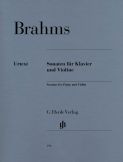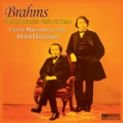Sonatas For Violin & Piano Paper
Sonatas For Violin & Piano Paper
* Estimated price converted from UK retail price
Johannes Brahms' 3 Sonatas for Violin and Piano are published here in the edition by Hans Otto Hiekel the fingering of the piano part by Hans-Martin Theopold and fingering and bowing of the violin part by Karl Rohrig.
Preface
This volume, newly checked, contains Brahms’s three sonatas for violin and piano with the Scherzo WoO 2 contributed by him as the third movement of a joint work for Joseph Joachim; Schumann composed the 2nd and 4th movements, his pupil Albert Dietrich the 1st. The completed Sonata bore the initial letters of Joachim’s motto, F.A.E. (“Frei, aber einsam” = free but lonesome).
As sources, Brahms’s personal copies were available, i.e. the first editions with modifications in his own hand. Autographs are available only for op. 78, the first movement of op. 100 (bars 1–268), and the Scherzo. For op. 78 reference was also made, for the first time, to Franz Hlavaczek’s copy with Brahms’s own emendations, which had served as the engraver’s copy for the first edition. This copy is in private possession in Vienna. We are particularly indebted to the following libraries for placing source material at disposition: Gesellschaft der Musikfreunde, Vienna; Stadt- und Landesbibliothek, Vienna; Deutsche Staatsbibliothek, Berlin; and Biblioteka Jagiellopska, Cracow.
With respect to the rather rapid tempo of the third movement of op. 78, an interesting modification in the sources indicates a more moderate tempo. In the autograph, Brahms replaced the non troppo with moderato, and in the Hlavaczek copy, he added molto to the moderato. – In the piano part of the same movement, the sources have no natural before the 14th sixteenthnote in bars 4 and 64, likewise before the 12th sixteenthnote in bar 55. In the first movement of op. 108, the different positions of the crescendo and decrescendo signs in bars 3 and 4 of the violin part and all parallel passages have been reproduced exactly as they appear in the sources, but these divergencies do not imply that Brahms intended a different rendering.







